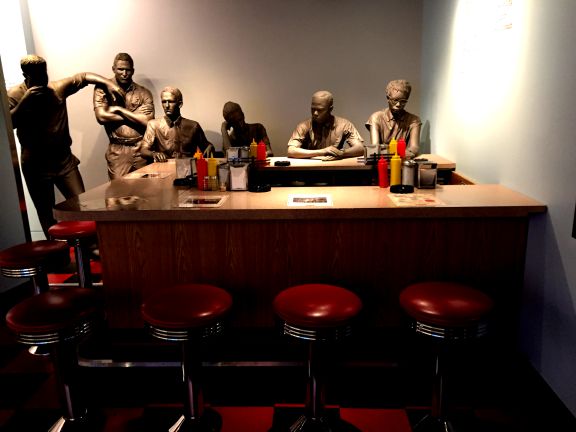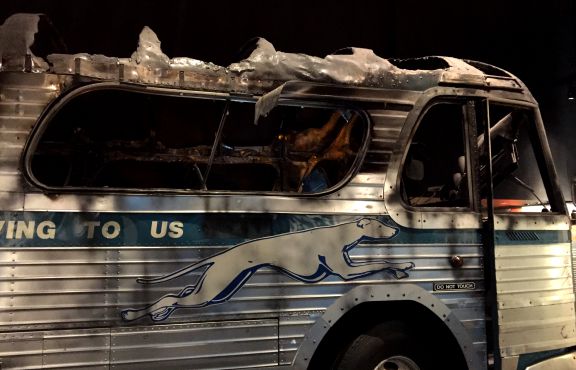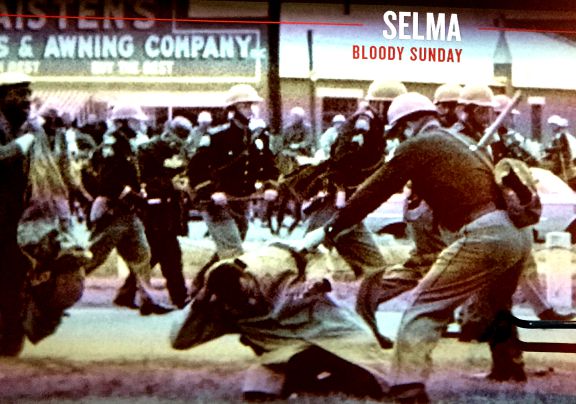He guided our nation toward its best self.

Lunch Counter at the National Civil Rights Museum
He was the very embodiment of the determined and courageous, young patriots who founded this country. John Robert Lewis was a son of the South, a pillar of strength, honor, and integrity in Washington, and in the eyes of his friends and colleagues, he was “the Conscience of Congress.” He loved the United States, and he lived his entire life trying to guide it toward being its best self. He might also have been the “Conscience of Our Nation.”
An examination of the life of John Lewis is a history lesson in the civil rights movement. He was part of the sit-ins at all-white lunch counters in Nashville, which resulted in their eventual desegregation. He was a volunteer “Freedom Rider” on buses traveling across the South in an effort to desegregate restrooms and lunch counters in bus terminals. He was one of the founders of the Student Nonviolent Coordinating Committee, and eventually, its chairman. In that role, Lewis was the youngest speaker at the 1963 March on Washington, preceding Dr. Martin Luther King, Jr’s. delivery of his “I have a dream” speech. In 1965 he was beaten by a state trooper with a club as he led a peaceful protest across the Edmund Pettus Bridge in Selma, Alabama. That event, known as “Bloody Sunday,” was one of three peaceful marches from Selma to Montgomery that later that year resulted in the passage of the Voting Rights Act.
John Lewis was arrested on Bloody Sunday, one of 45 times that he was incarcerated throughout his life’s mission of getting into “good trouble” to enact change. On that March day in Selma, Lewis anticipated that he would be arrested at some point during the march to Montgomery. So, he had on a backpack in which there were two pieces of fruit, a toothbrush and toothpaste, and two books, one by a professor of political science at Harvard and the other by the monk, Thomas Merton.

Freedom Rider Bus Burned in Anniston, AL
John Lewis was passionate, consistent, and propelled at his core by love. He was driven to peaceful revolution from the time, at an early age, that he was denied the privilege of checking a book out of a public library because he was black (colored). From the beginning of his life-long quest to affect change, he never wavered from his dedication to transforming unjust practices through nonviolent means. Ever.
His ill-health prevented active participation in the recent protests against the inequalities that continue today, but for that, nothing could have silenced the voice of John Lewis. When he witnessed the beginning of the recent demonstrations, he marveled at seeing people unite from all over the world, from all walks of life, all ages, black, white, Latino, Asian-American, and Native American for what have “largely” been peaceful protests.

Photo at the National Civil Rights Museum of the beating of John Lewis on the Edmund Pettus Bridge
Lewis would never have condoned the violence that has happened in some parts of the country. He knew that force was only an impediment to the ultimate goal. In Walking with the Wind: A Memoir of the Movement, Lewis wrote, “Rioting is not a movement. It is not an act of civil disobedience. I think it is a mistake for people to consider disorganized action, mayhem, and attacks on other people and property as an extension of any kind of movement. It is not. It is simply an explosion of emotion. That’s all. There is nothing constructive about it. It is destructive.”
John Lewis represented the very best of our country. He exemplified the most honorable among us. President Barack Obama said of him, “He loved this country so much that he risked his life and his blood so that it might live up to its promise. And through the decades, he not only gave all of himself to the cause of freedom and justice, but inspired generations that followed to try to live up to his example.”
We, as a nation, owe a great debt of gratitude to Congressman John Lewis. His integrity, honor, bravery, and dedication set a high moral bar that we and our leaders would do well to strive to achieve.
Deborah Fagan Carpenter, July 21, 2020
All photos by Deborah Fagan Carpenter, taken at the National Civil Rights Museum



Yes, John Lewis was all those things, did all those things, and called us to all things good and just. Hero? O my! If not, John Lewis, who?
Now, a word about her.
She was 11, barely 12 perhaps, when on Saturday August 26, 1961, in her hometown of McComb, Mississippi, African-Americans, Hollis Watkins and Elmer Hayes, “sat-in” at the downtown Woolworth lunch counter taking the first direct action against segregation in her home state.
She was 14, barely 15 perhaps, when in 1964, SNCC (Student Non-Violent Coordinating Council), the civil rights organization co-founded by John Lewis, chose Mississippi, with her hometown of McComb as the epicenter, as the battleground for civil rights for African- Americans. She saw two-thirds of the acts of violence in that “Freedom Summer of ’64” take place in her home county, including 19 bombings of Black churches and residences in her town, decried as “The Bombing Capitol of the World.”
She was 15, when 90% of her hometown citizens voted for Barry Goldwater, who had strongly opposed the Civil Rights Act of 1964.
She was there when her hometown narrowly escaped martial law in ’64, for its violence in opposition to civil rights.
So, would one expect the beautiful tribute to Mr. John Lewis above to flow from the pen of a White native of “The Bombing Capitol of the World?” Perhaps; because McComb is filled with genuinely good, never-violence-condoning, non-racist persons. Moreover, countless numbers of us ex-residents of McComb stand for liberty and justice for all.
Then there’s Deborah Fagan Carpenter.
Deborah lifted up her voice and her pen, courageously, especially considering our hostile times and national crisis. There are different ways to be heroic. Were he here, I believe John Lewis would say, “Ms. Carpenter found one.”
Wow! I’m speechless, Randall. I’m happy to even stand in the same paragraph with you. Thank you.
She paints with oil and brushes;
she paints with words and truth.
Beautiful portrait of a great soul!
Thanks for the gift, Deborah.
What a lovely thing to say, Randall. Thank you so much!